Although not as high-profile as other animals in the national parks, like bison, moose and grizzlies, mountain goats are actually among the park system’s most iconic species.
Characterized by a long face, sharp black horns, a beard and a double coat of white wool and hair, these odd-looking animals are among the rarest large mammals in the United States.
Contents
Best National Parks to See Mountain Goats in the Wild
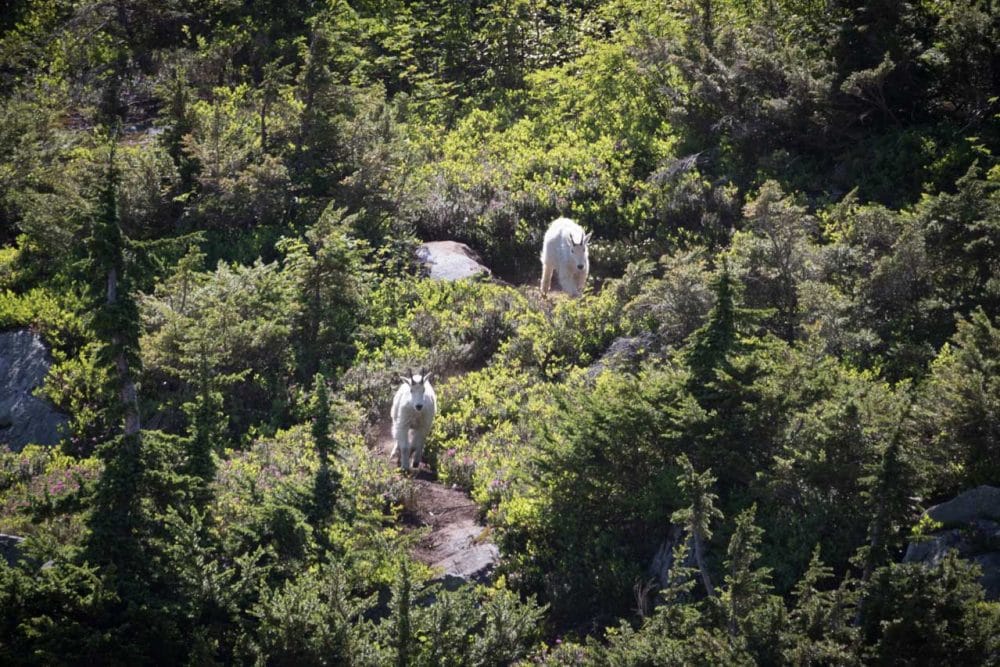
The natural range of mountain goats (Oreamnos americanus) stretches from the northern Rocky Mountains to the northern Cascade Range and into southeastern Alaska.
This includes five national parks. In these parks, mountain goats thrive in their native habitat, delighting visitors with their cliffside acrobatics.
Fun fact: Mountain goats aren’t actually goats at all. Although both true goats and mountain goats are members of the Bovidae family and Caprinae subfamily (which also includes sheep, chamois, muskox and ibex) they are a different genus—Capra and Oreamnos respectively. Mountain goats are only found in North America and are the only surviving species in the Oreamnos genus.
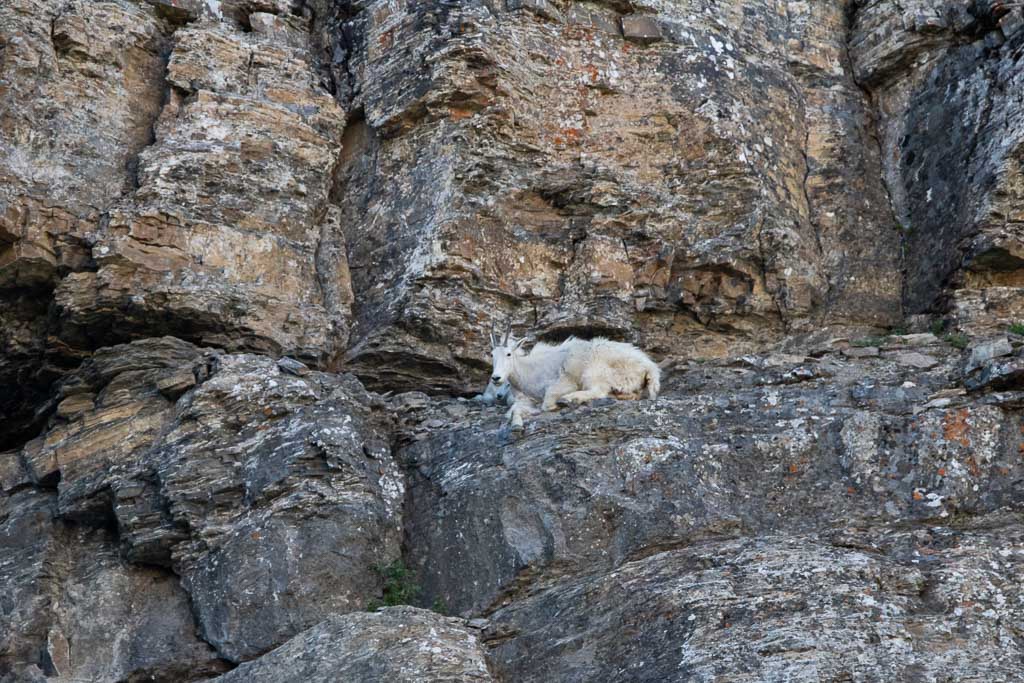
This post about the best national parks to see mountain goats in the wild contains affiliate links. You can read more about our Terms of Use / Disclosure here.
You Can See Native Mountain Goats in These National Parks
Since, as their name implies, these iconic national park mammals live in mountainous regions, you’ll often to need to either drive or hike to high-elevation areas to see mountain goats in the wild.
A primary alpine and subalpine species, they typically stay above the tree line, where they roam slopes, ridges and meadows, and can be seen up to as high as 13,000 feet (4,000 meters).
You can see mountain goats in national parks in the northern Rocky Mountains, Pacific Northwest and Alaska. The following five parks offer the best opportunities to see them in their native habitat.
Note: Mountain goats have also been introduced in several other parks and places elsewhere in America, including Wyoming, Colorado, Nevada, Oregon and Washington’s Olympic Peninsula. However, considering the fact they’re a non-native—even invasive—species in those parks, I won’t discuss them in greater detail in this post.
Glacier National Park, Montana
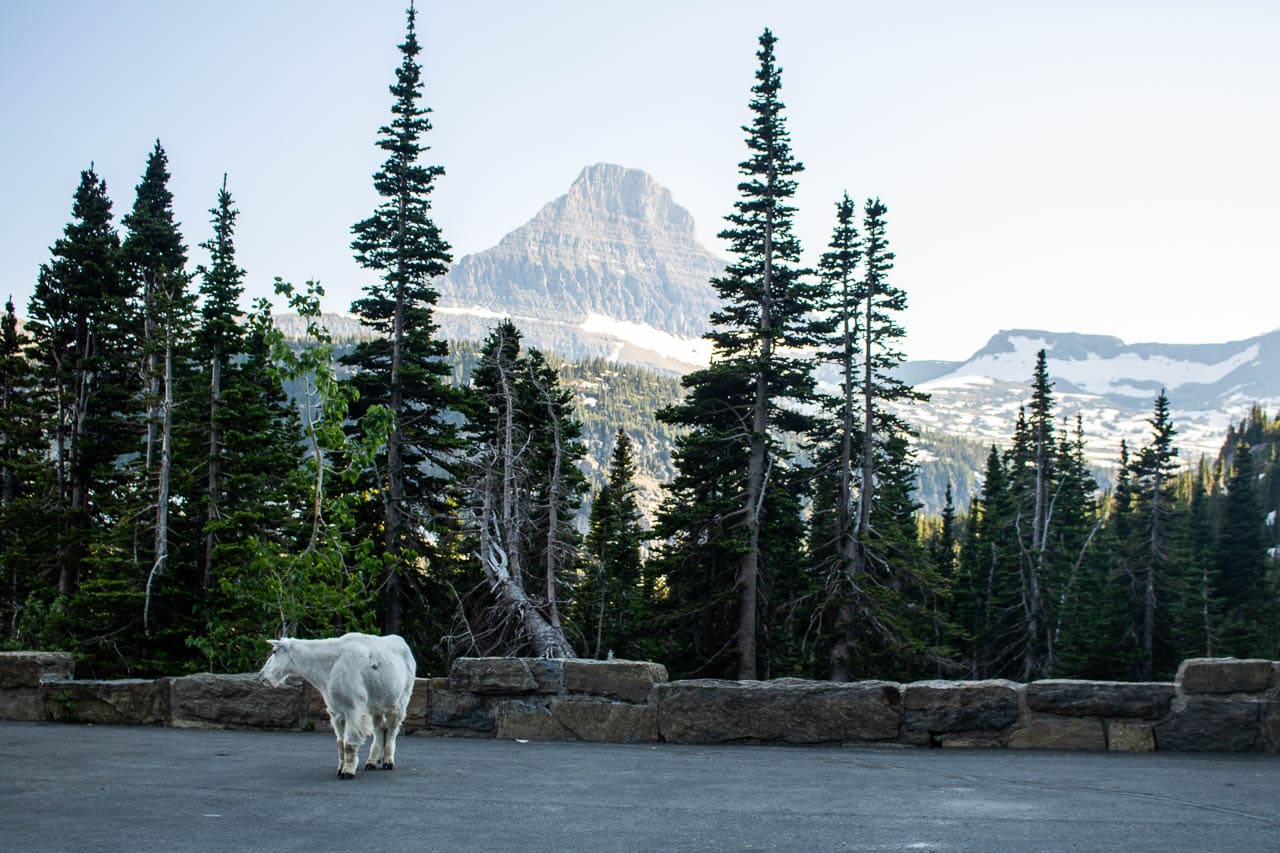
Featured on the logo of the Great Northern Railway, mountain goats are the official symbol of Glacier National Park, which should tell you that your chances of seeing one are pretty high.
These hardy animals aren’t afraid of harsh Rocky Mountain winters, while also being agile enough to outmaneuver predators like bears, wolves and eagles.
When visiting spectacular Glacier National Park, you can see mountain goats wandering along the park’s high cliffs, steep slopes and boulder fields. They remain there throughout the entire year.
Visitors regularly encounter them on higher-elevation hiking trails in Glacier National Park.
Logan Pass, the highest point on the spectacular Going-to-the-Sun Road, is famous for its alpine animals, including mountain goats, but also marmots, pikas and bighorn sheep. It’s easily one of the best places to see wildlife in Glacier.
Where to See Mountain Goats in Glacier National Park
- Logan Pass Visitor Center
- Hidden Lake Overlook Trail
- Highline Trail
- Grinnell Glacier Trail
- Ptarmigan Tunnel Trail
More About Glacier National Park
- Park Website
- Travel Guide
- Topographic Map
- Best Glacier Hikes
- Top Attractions on Going-to-the-Sun Road
- Accommodation
Mount Rainier National Park, Washington
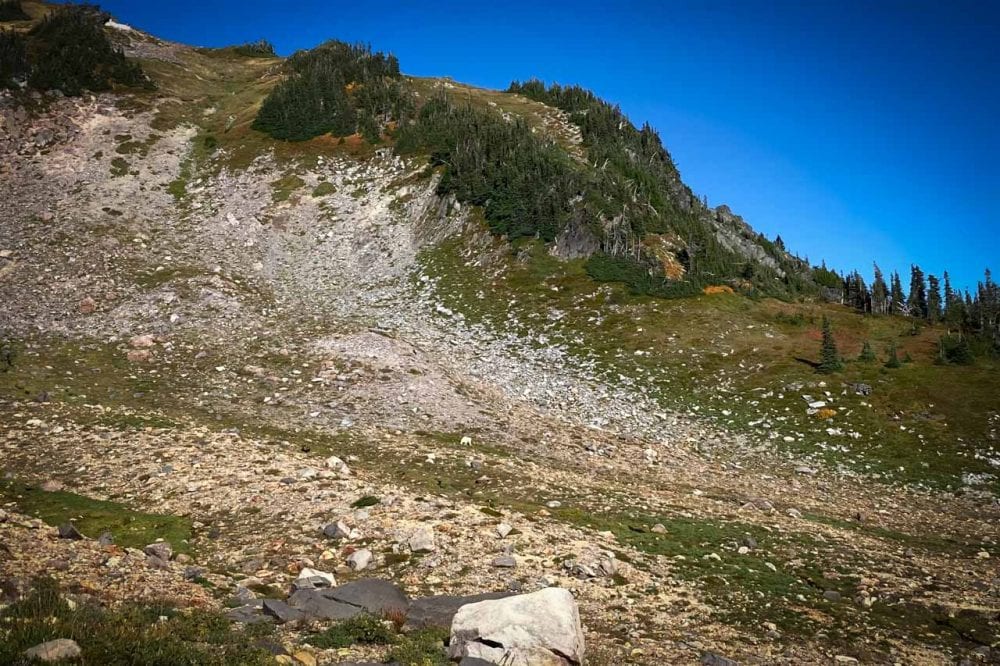
Mount Rainier National Park is the southernmost national park where you can see mountain goats in their native habitat. It marks the southern edge of the natural range of these beautiful alpine animals.
A park characterized by massive glaciers, tundra-like environments, high-elevation meadows and rocky slopes, Mount Rainier is prime mountain goat habitat. You can see them in the park’s subalpine and alpine areas, where they stay even during winter.
Although Mount Rainier National Park has two high-altitude areas that are accessible by car—Paradise and Sunrise—you’ll have to hike to get to the places where mountain goats reside. Luckily, there are several fantastic trails in Mount Rainier National Park for wildlife viewing.
If you can, I suggest visiting Mount Rainier in late-September or early-October, when fall foliage is peaking and there’s the least amount of snow on the higher slopes.
On our fall hikes at Mount Rainier, for example, we saw about a dozen mountain goats and half a dozen black bears. I strongly recommend hiking the Skyline Trail (Paradise) and the Burroughs Mountain Trail (Sunrise).
Where to See Mountain Goats in Mount Rainier National Park
- Skyline Trail
- Burroughs Mountain Trail
- Glacier Basin Trail
- Summerland Trail
More About Mount Rainier National Park
- Park Website
- Travel Guide
- Topographic Map
- Best Mount Rainier Hikes
- Top Things To Do in Mount Rainier National Park
- Viewpoints
- Accommodation
North Cascades National Park, Washington
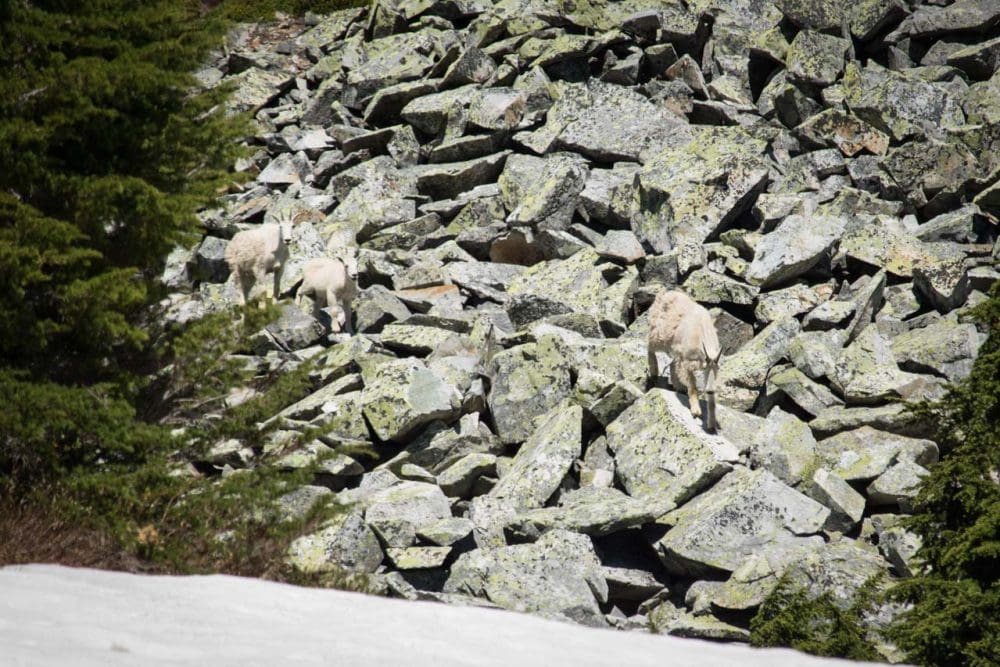
The crags, ridges and rugged peaks of the North Cascades are the ideal home for mountain goats.
Their strong muscular legs and soft sandpaper-like hooves—unique in the animal world—allow them to thrive in this mountain wilderness in northern Washington.
In North Cascades National Park, mountain goats spend their summers at elevations above 5,000 feet (1,500 meters).
They hang out around snowfields, glaciers and rocky slopes, and are often seen in high-altitude meadows, browsing on huckleberries and other shrubs.
Numerous family groups of mountain goats live around Mount Baker and many other peaks in the North Cascades.
While it’s impossible to tell what exactly their range is—tagging them is both difficult and dangerous work—you can increase your chances of seeing mountain goats in the North Cascades by hitting some of the park’s higher trails.
We saw several on the phenomenal Cascade Pass Trail, one of the greatest national park day hikes in the system.
Where to See Mountain Goats in North Cascades National Park
- Cascade Pass Trail
- Maple Pass Loop
More About North Cascades National Park
- Park Website
- Travel Guide
- Topographic Map
- Top Things To Do in North Cascades National Park
- Accommodation
Kenai Fjords National Park, Alaska
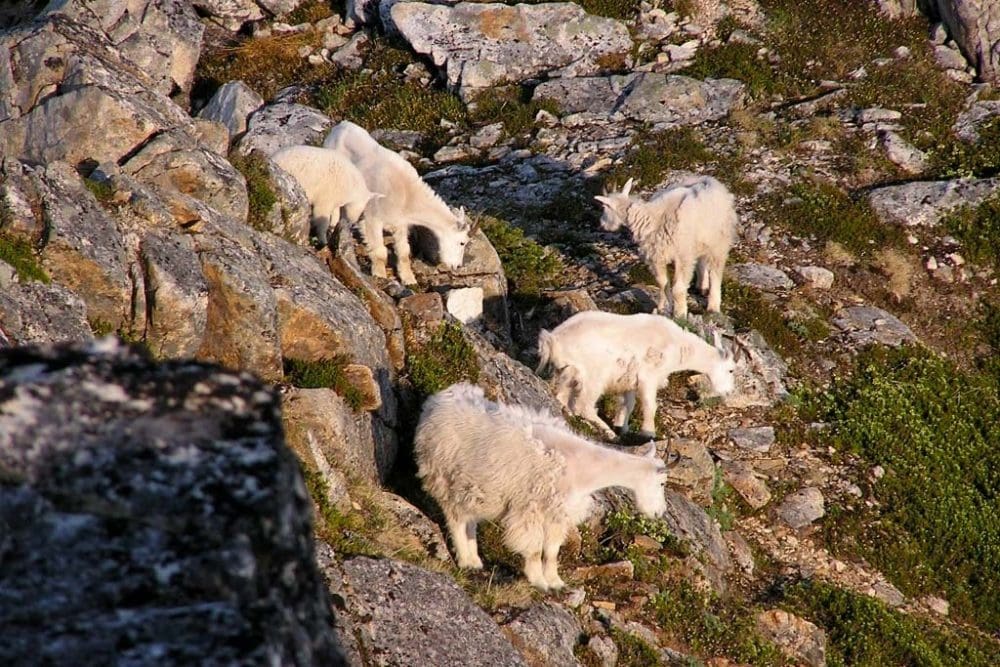
Regularly seen on the cliffs, slopes and coasts of southeastern Alaska, mountain goats are abundant in Kenai Fjords National Park. The population of mountain goats on the Kenai Peninsula ranges between 3,600 and 4,600 animals.
In late-spring and summer, you can often see them along the Harding Icefield Trail, while people on Resurrection Bay boat tours regularly spot mountain goats between Callisto Head and Caines Head.
That latter area is so amazing for viewing mountain goats it’s been nicknamed “goat alley”. Especially from late-May to early-June, the shoreline is a great place to see nannies—the name for female mountain goats—and young kids.
Later in summer, they move to higher areas where they gather in large group all around Resurrection Bay.
Where to See Mountain Goats in Kenai Fjords National Park
- Harding Icefield Trail
- Resurrection Bay, between Callisto Head and Caines Head
More About Kenai Fjords National Park
Glacier Bay National Park, Alaska
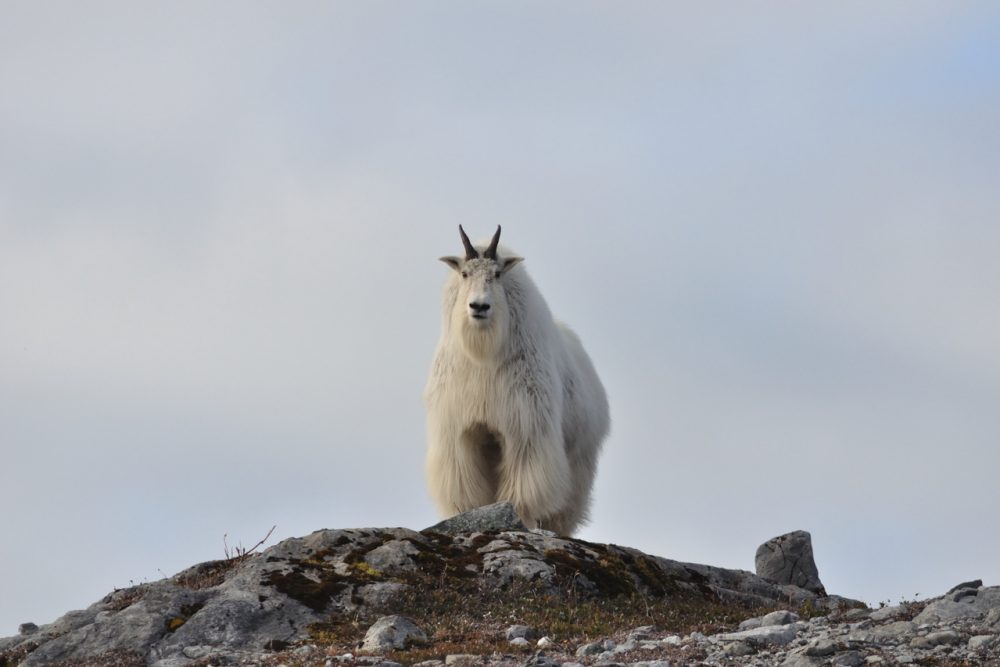
A wildlife paradise in Alaska‘s panhandle, Glacier Bay National Park is home to all kinds of marine mammals, from harbor seals, Steller sea lions and sea otters to orcas and humpback whales.
The park also protects habitats for a variety of land animals, including moose, brown bears and—you guessed it—mountain goats.
In fact, mountain goats may have been one of the very first animals to recolonize Glacier Bay after the icesheets retreated.
Thanks to the special shape of their hooves, these even-toed ungulates can effortlessly hop, skip and jump on the steepest of ledges—they can jump up to 12 feet (4 meters) in one leap!
On a Glacier Bay cruise, the most popular and easiest way to visit this rugged park, you can often see them on the rocky cliffs in the middle and upper parts of the bay.
Watch for moving white spots against the gray background of the rocks. (These are the binoculars I use for wildlife viewing.)
Where to See Mountain Goats in Glacier Bay National Park
- Coastal cliffs in the middle and upper parts of Glacier Bay
More About Glacier Bay National Park
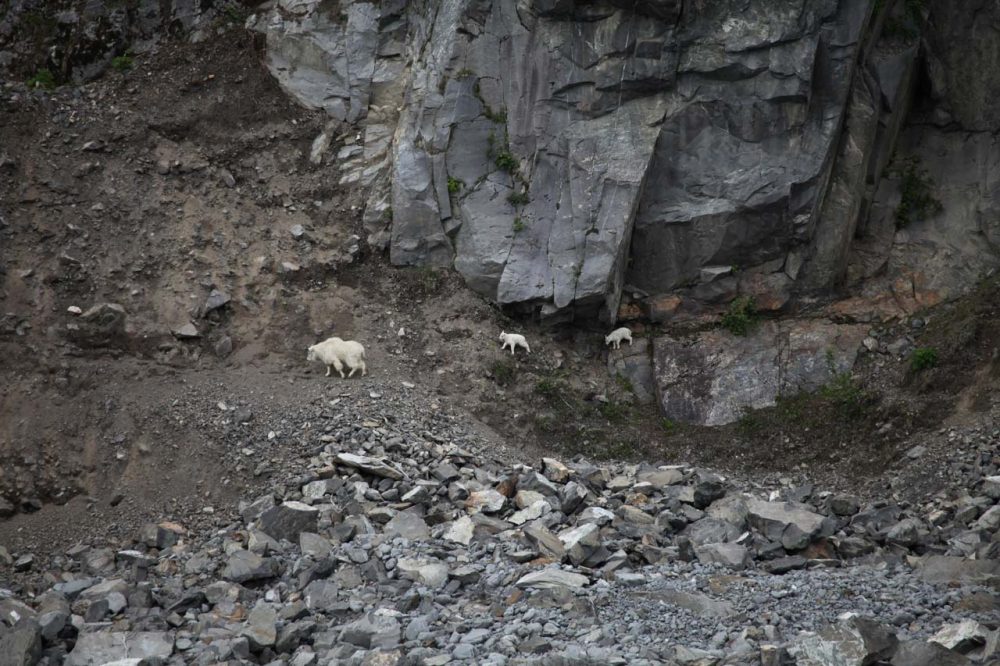
Other National Parks With Mountain Goats
In addition to the national parks that have native mountain goats above, there are a few other parks where you can also see mountain goats in the wild.
However, like I said earlier, those are introduced populations. While abundant in parks like Yellowstone, Grand Teton and Rocky Mountain, they aren’t actually native to those areas.
- Yellowstone National Park, Wyoming, Idaho and Montana
- Grand Teton National Park, Wyoming
- Rocky Mountain National Park, Colorado
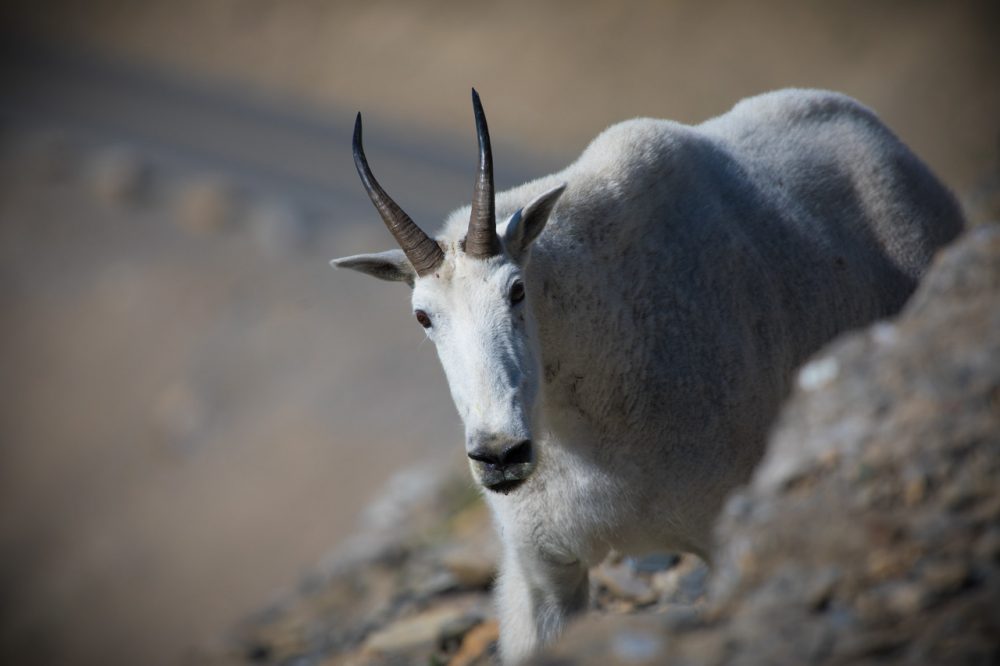
Mountain Goat Safety Tips
As exciting as it is to encounter a wild mountain goat on a trail, you have to remember that these animals are, in fact, wild.
They may act aloof and seem relaxed, but they can be aggressive. This is especially true if you’re dealing with a nanny with kids or a male goat during the fall breeding season.
Although physical confrontations are rare, people have been gored and even killed by mountain goats before—they use their sharp horns to defend themselves.
So, when you’re hiking in mountain goat country, it’s important to keep a handful of safety guidelines in mind.
- Stay at least 50 yards away from mountain goats at all times. This is the length of half a football field.
- Use binoculars or a telephoto lens to view or photograph them.
- Don’t pee on or near the trail. Goats crave salts and may seek out human salts in urine and sweaty clothes. Pee at least 50 yards from the trail on a rock or bare ground. Don’t leave sweat-soaked clothes lying around; goats may actually chew them.
- If approached by a mountain goat, slowly back away to a safe distance. If the goat follows you, you should be prepared to chase it off. Yell, wave your arms or clothes, throw rocks.
- Never approach a mountain goat and invade its space yourself!
Have You Ever Seen Mountain Goats in a National Park? Share Your National Parks Experience Below!
Other Iconic National Park Wildlife
- American Bison: Best National Parks to See Them
- Black Bears: Best National Parks to See Them
- Grizzly Bears: Best National Parks to See Them
- Wolves: Best National Parks to See Them
- Orcas: Best National Parks to See Them
- Moose: Best National Parks to See Them

Amy
Wednesday 14th of April 2021
Thanks for sharing our Glacier post - This is a great list of places to see mountain goats. We've also seen them in Olympic National Park as well!
Bram
Wednesday 14th of April 2021
You're absolutely welcome!